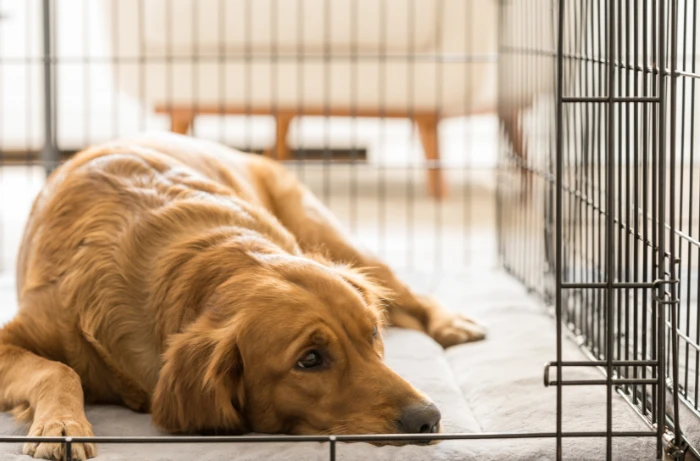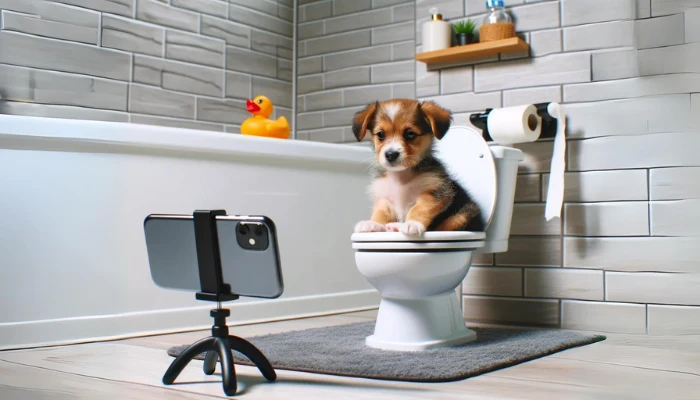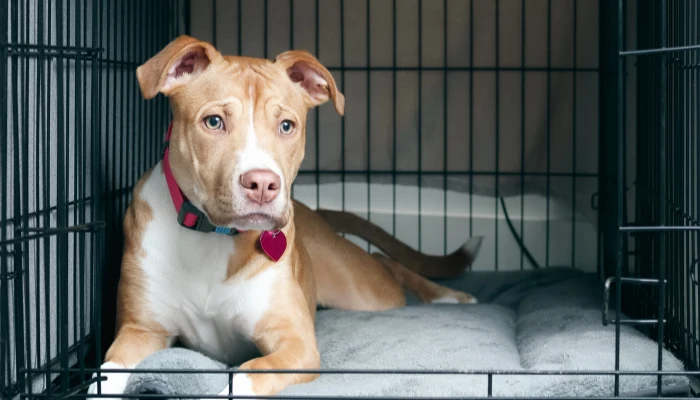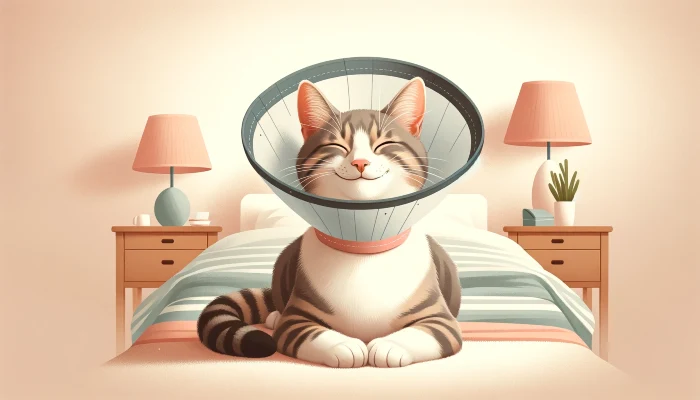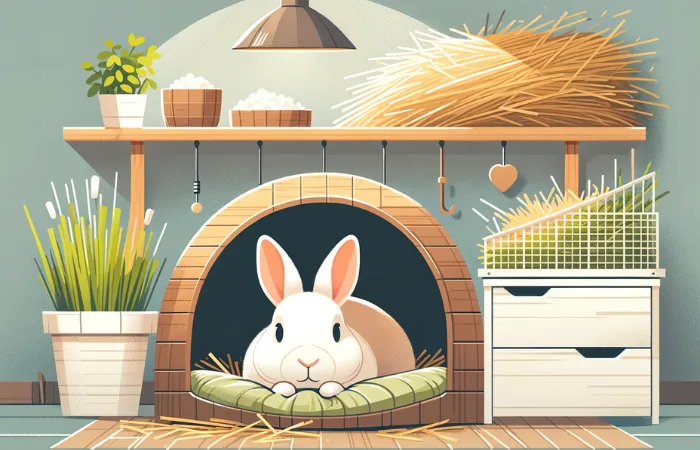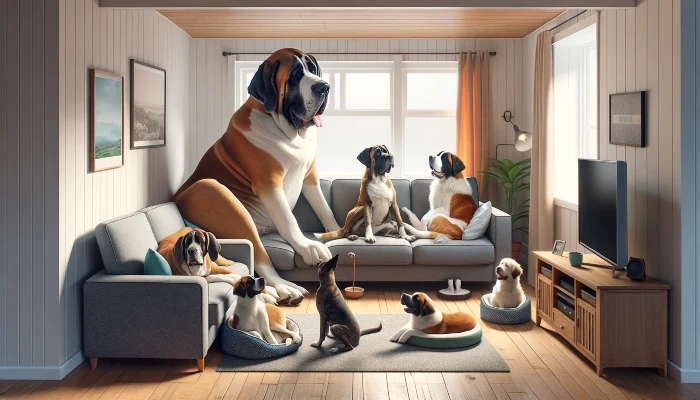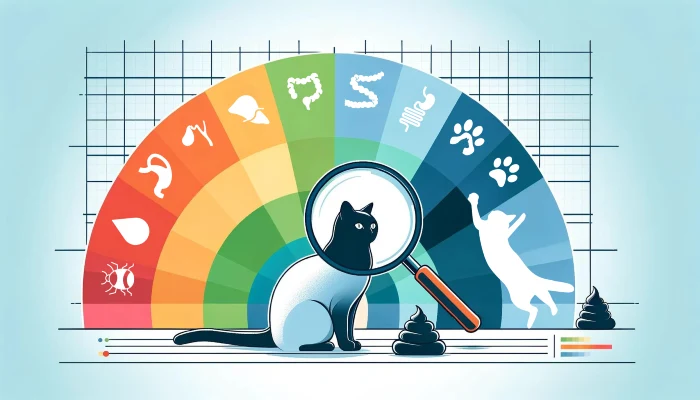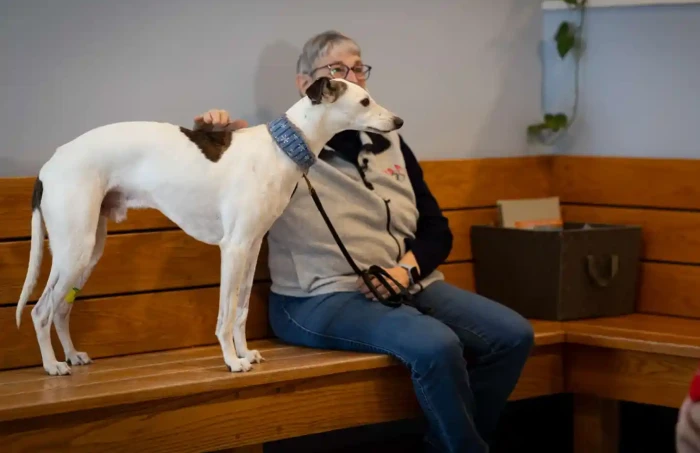Alright, let’s talk about the “crater haters” for a moment. You know, those folks who instantly shudder at the mention of crates, ready to label them as cruel and inhumane.
Hold on a sec, folks! We’re not looking at this from the right angle.
Let’s clear up a common misconception here. A crate isn’t a cage of torment; it’s not where your dog’s dreams of freedom go to die. It’s about understanding your furry friend’s perspective, not just your own architectural preferences.
You see, humans and dogs have different ideas about personal space. While we’re all about spacious living and sprawling acres, our canine companions are natural den dwellers.
They fancy cozy corners, snug spaces, and that pitch-black comfort. Think about it—why do they love sliding under your coffee table or snoozing under the covers? It’s their natural instinct to create their little safe haven.
Even those bold pups who can’t resist basking in the sun or frolicking in the fields eventually retreat to their snug spots.
Now, don’t get me wrong. Dogs adore their sun-soaked escapades, but when the day winds down, they’re seeking that snug hideaway within your home.
Even the most sociable dog will find their own little corner, be it snuggled between the couch cushions or cozied up on their bed.
So, that kitchen space, utility room, or guest room you thought was just a room?
Guess what, you’ve unwittingly created a den for your four-legged friend.
So, what’s a crate in this picture? It’s like a den on steroids, a secure haven for your dog when you can’t keep a watchful eye on them.
Whether your pup’s a seasoned crate enthusiast or a newbie, it’s all about providing a safe spot when you’re not around.
Now, here’s the kicker—this is not a punishment pod, folks.
No timeouts or anger-fueled confinement.
It’s all about positive vibes here.
Remember, a crate is your dog’s cozy corner, their safe retreat, not a prison cell.
And I’ll let you in on a little secret: while not every dog needs a crate, a majority of pups, especially puppies and new adoptees, could use some crate training magic. It’s like their own little training ground, where they learn the ropes of your house.
It’s a fantastic tool for guiding them away from destructive tendencies, like redecorating your shoes or sampling your underwear collection.
And hey, even adults need a refresher course sometimes.
Think of it this way: for potty training, a crate is like your secret weapon. Those puppies can be quite the whirlwind, but a crate helps them grasp the bathroom etiquette quickly.
And guess what?
Even seemingly house-trained adult dogs might need a refresher. The crate, my friend, is a ticket to errorless house training.
Now, here’s the scoop: for fully trained adult dogs, a crate isn’t their mainstay. Most of them can handle the freedom, navigating the home without getting into any antics.
Well, unless there’s a specific behavior we’re ironing out, and that’s when the crate becomes a secret weapon again. But remember, when things get a bit tricky, consult an expert.
But even if your dog isn’t a hardcore crate fan, having crate-trained chops is a mark of character.
You see, there will be times when your furry buddy needs to hunker down in a crate, whether it’s at a dog hotel while you’re on vacation, or during a vet visit, or even at the groomer’s. Traveling?
Well, a crate turns into a secure car compartment for your buddy. It’s like their private suite on wheels, and it ensures they don’t suddenly decide to play backseat driver while you’re navigating the streets.
So, here’s the takeaway: a crate isn’t a “one-size-fits-all” solution, but it’s a skill your dog should have up their furry sleeve. Plus, it’s a safety net.
With a crate in their skill set, your pup is prepared for any situation, even if it’s just some downtime in their own cozy corner.
So, next time you think of a crate, picture it less as confinement and more like a VIP den, a handy hideout tailored just for your four-legged friend.
The Crate Menu: A Smorgasbord of Options for Every Pooch
Alright, now that we’re all aboard the crate train, let’s dive into the fascinating world of crate options. Think of it as a menu for your furry foodie, but instead of treats and kibbles, it’s a smorgasbord of cozy corners tailored to your pup’s taste.
First up, the Plastic Crate: Picture this as your dog’s first class ticket to cozy town. These crates are a breeze to clean, making those little messes far less daunting.
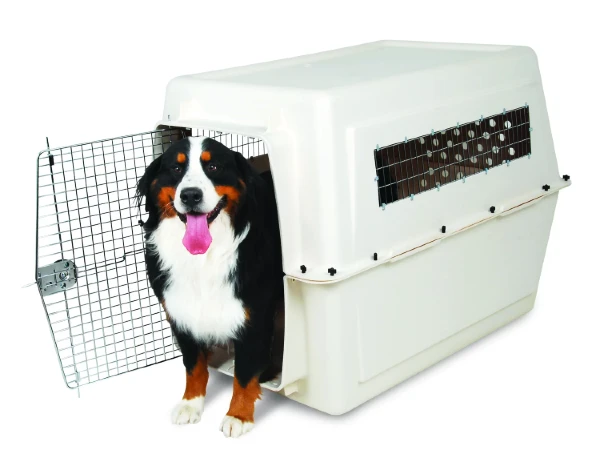
And for those epic messes? No problem, just disassemble the crate for a deep clean operation. They’re like the dog version of a luxury hotel—warm, dry, and easily transformable into a sanctuary with a simple blanket.
Plus, they’re your car’s best friend, designed for a snug fit and secured with those cool strappy systems. They even come with VIP options for smaller dogs, making them the stars of the travel show.
Remember, if your pup’s hitting the skies, plastic crates are the way to go, meeting airline safety standards with panache.
Up next on our crate culinary tour, we have the Wire Crate: A versatile option that’s all about that open-concept living. Think of it as the loft apartment of crates. They fold up like a dream, making storage or travel a breeze.
These crates are your pup’s window to the world, offering plenty of visibility and airflow. Just remember, size matters with these—going big might give you a workout.
And while they’re fantastic for road trips, they’re not plane-friendly (these crates are, though). Still, they’ve got your wallet’s back with their affordable options.
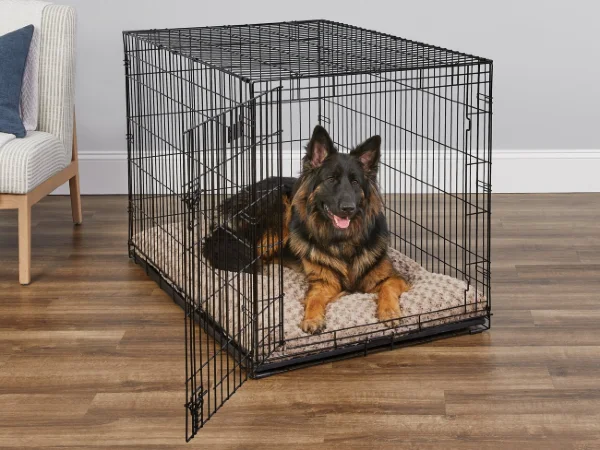
Let’s spice things up with a touch of Soft Sided Crate: These lightweight beauties are perfect for the jet-setters.
Nylon, vinyl, and aluminum create a snug yet flexible abode for your pup on the go. They’re your travel buddies, setting up camp in hotels or campgrounds with ease.
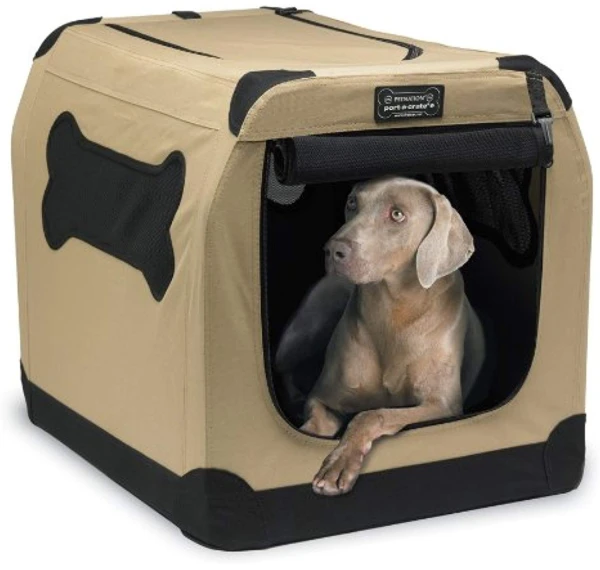
But here’s the deal—these aren’t your go-to crate training tools.
They’re more like the vacation homes of the crate world, perfect for dogs who’ve already graduated from crate basics.
Feeling fancy?
Time to savor the allure of the Fashion Crate: This is where function meets style.
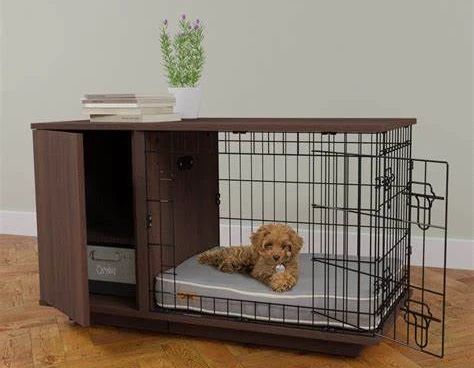
These crates are like the designer purses of the crate universe. Made from finer materials, some even blend seamlessly into your furniture.
Picture a crate that’s practically a statement piece in your home.
But hey, it’s not just about the looks—it’s about utility too. These are your inclusion-time buddies, ensuring your pup’s part of the action.
For those seeking the ultimate protection, there’s the Heavy Duty Crate: These crates are like the armored vehicles of the crate world.
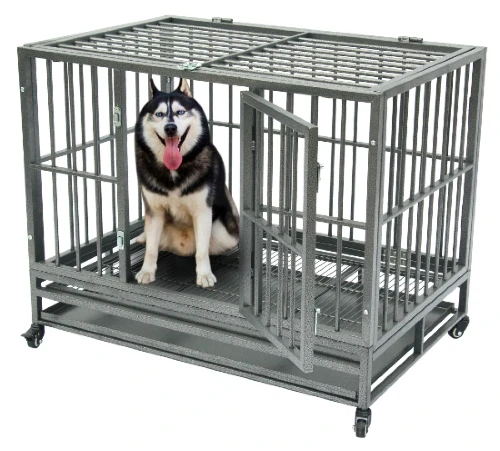
Mainly used by globetrotting owners and their canine companions, they’re built to withstand even the most intense car crashes.
Yep, you read that right.
Your pup’s safety is the number one priority here, making these crates the Fort Knox of dog enclosures. But fair warning, these heavyweights also come with a heavyweight price tag.
Oh, and let’s not forget the versatile X-Pens: They’re like the Swiss Army knives of dog spaces.
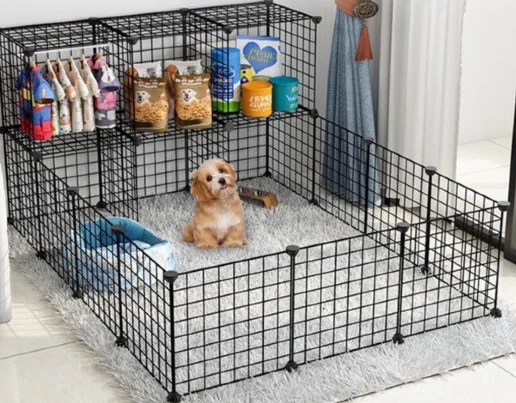
Perfect for those in-between stages, these are fantastic tools for integrating your pup. Ideal for puppies and smaller breeds, they’re a moveable haven that folds up as easily as a wire crate.
Just remember, these aren’t the best choice for larger or energetic dogs. Think of them as the puppy preschools of the doggie world.
Now, if you’re scratching your head, unsure which crate to choose, why not have a smorgasbord of options?
Many experts suggest starting with both a plastic and a wire crate.
It’s like a two-for-one deal for your pup’s comfort and your peace of mind. The plastic one’s your inclusion hotspot, perfect for family hangouts, while the wire one’s the “quiet crate,” providing your furry friend some peaceful alone time.
As you explore the crate buffet, remember, the size is everything.
Your pup should be able to stand tall, do a little twirl, and stretch out for a snooze without feeling cramped.
While crate selection might feel like picking out a tailored suit for your pup, it’s an investment in their comfort and well-being. And for those puppy parents, a wire crate often comes with a handy-dandy divider, so you can shrink the space while they’re still pint-sized, then expand it as they grow.
So, whether you’re going plastic for puppy time, wire for your seasoned explorer, or fashion for your trendsetter, there’s a crate for every doggy palette.
Just remember, this is your pup’s cozy corner, their haven, and their own special retreat.
Crate Training Tips: Mastering the Art of Happy Hounds
Now that we’ve set the stage for the crate training symphony, let’s fine-tune our conductor’s baton and delve into the nitty-gritty of making crate training a harmonious experience for both you and your furry friend.
First things first, if your dog has a history of crate-related trauma or is grappling with separation anxiety, it’s time to call in the experts.
Trying to DIY this situation can be like attempting to fix your car’s engine with a butter knife—it’s just not going to cut it.
So, if your pup’s crate-phobia is more than just a passing phase, consult a trainer or behavioral consultant who can orchestrate a customized solution.
For the rest of our four-legged pals, let’s break down this process like a pro. The goal is to make the crate a safe haven, a retreat that your pup actually wants to hang out in.
Think of it as your dog’s cozy reading nook, their private den of relaxation. We’re aiming for a neutral response at minimum, but a Conditioned Emotional Response? Well, that’s the jackpot.
As with any training, timing is crucial. Remember, don’t embark on crate training during the canine equivalent of a caffeine-induced rave.
Your dog’s energy levels matter, so tire them out before crate time. Think of it as setting the stage for a chill evening at home. Your secret weapon? Praise. Shower your pup with accolades for entering the crate.
More To Discover
- Disaster Preparedness for Pet Owners (7 Tips To Follow For Peace of Mind)
- CBD for Pets: Unleashing the Secret to Happy Dogs and Contented Cats!
- Blue Ridge Beef Expands Pet Food Recall in 16 States Over Salmonella and Listeria Risks
- Flying with Your Dog in Cabin: The Ultimate Guide for a Smooth Journey (In Just 5 Steps)
And yes, your voice is the MVP of your training toolkit.
Consider introducing a consistent cue phrase to signal crate time, and voilà, you’ve got a canine compass pointing toward their cozy corner.
But hey, we’re not done yet. Before we proceed, let’s talk door etiquette. Tie it back initially, so it doesn’t become an accidental spook-fest for your pup.
Nobody wants their furry friend scared of a swinging door.
And remember, Rome wasn’t built in a day, and neither is crate training.
Now, let’s ensure your pup feels right at home. Keep a stash of treats on the crate for easy pre-baiting. Throw in a chew toy or two, and you’re ready for action.
Oh, and a little tip: don’t stick to a predictable routine during initial training.
Shake things up to keep your pup on their paws. We’re disrupting the patterns to create a flexible, adaptable, and happy crate experience.
A quick note for those barky beginners—don’t let your pup hijack your freedom.
If they’re barking up a storm to get out, don’t succumb. Instead, let patience be your guide, and gradually build up their crate stamina.
Remember, crate training might be a marathon, not a sprint, but the rewards are well worth it. With practice and patience, your pup should soon strut into their crate like it’s their VIP lounge.
Now, about crate liners—soft towels or mats work like a charm. If your pup has a knack for destroying beds, opt for a towel until their chew-toy manners are up to snuff.
And if you’re wondering about the potty breaks, follow the “one hour per month plus one” rule.
That’s your pup’s bladder-age equation.
For those furballs in potty school, arrange a lunch break or recruit someone for midday pit stops.
And a little housekeeping tip—no food in the crate. Remember, scheduled meals are the way to go, and the crate isn’t a snacking zone.
As for water, if your pup’s crate-time is limited, no need for a water bowl.
But if they’re hunkering down for a good chunk of time, consider a water bottle for clean, compact hydration.
So, whether you’re embracing the fashionista lifestyle with a sleek crate or introducing your pup to the ultimate safe haven, crate training is your pup’s passport to a cozy, secure corner in your home.
With a dash of patience, a sprinkle of praise, and a dollop of playtime, you’ll have your furry friend lounging in their crate like a true crate connoisseur.
So, go ahead, set up that crate like a pro, and watch your pup thrive in their new cozy kingdom. Your pup’s sense of safety and comfort is just a crate away!








